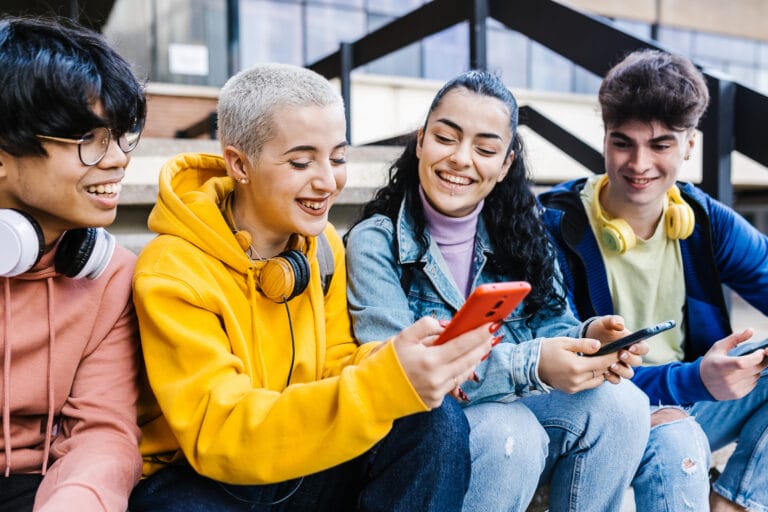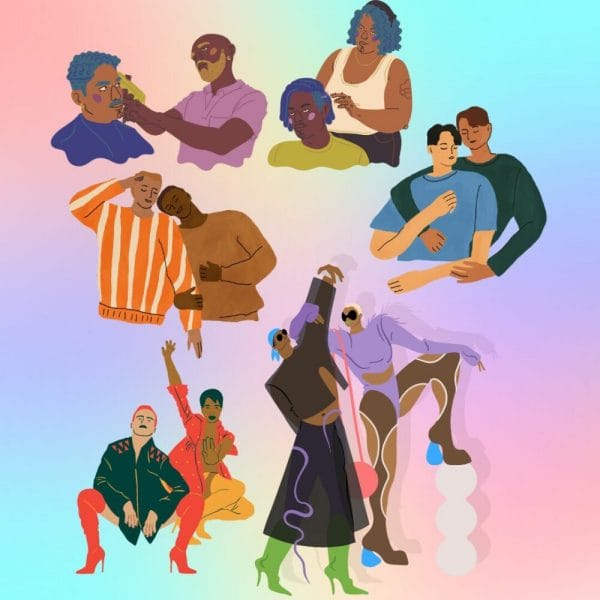Social media is fully ingrained in young people’s everyday lives, shaping how they connect, communicate, learn, and interact with the world. As social media has proliferated in young people’s lives, so have concerns about its role in the decline of youth mental health. Although concerns about the adverse effects of social media on young people are widespread, it is crucial to acknowledge the benefits it can offer as well.
The third installment of Hopelab’s National Survey, “A Double-Edged Sword: How Diverse Communities of Young People Think About the Multifaceted Relationship Between Social Media and Mental Health,” released in partnership with Common Sense Media, explores the nuances of the relationship between social media and youth mental health. Importantly, this survey was co-created with young people, who provided direction and input regarding survey content and worked with the study team to prioritize and interpret results. Teens and young adults — especially BIPOC and LGBTQ+ young people — bring their own unique lived experiences to social media spaces and, as a result, have different experiences with the content and communities they find there.
Many conversations surrounding social media and young people focus solely on harm and characterize them as passive users. This research shows that young people’s relationship with social media is much more complex. Social media is an important source of connection, support, and affirmation for young people, but it also brings challenges that young people navigate to minimize harmful impacts. There is an opportunity to use and understand this data to create better solutions grounded in the realities of young people’s experiences and needs.

Young friends watching social media content on smartphones
Evidence of ways social media may differentially support youth well-being
Research indicates that social media has a dual nature for young people, with both positive and negative implications. There is also great diversity in the ways social media impacts young people. As stated in the American Psychological Association’s Health Advisory on Social Media Use in Adolescence, “Social media is not inherently beneficial or harmful to young people…the effects of social media likely depend on what teens can do and see online, teens’ preexisting strengths or vulnerabilities, and the contexts in which they grow up.” Efforts to mitigate the harmful effects of social media must take into account the wide range of benefits it can offer young people and consider differential impacts across identities.
- Social Connection: Young people who are Black, LGBTQ+, or suffer from depressive symptoms are among those who ascribe even greater importance to the role of social media in helping connect with family and feel less alone. For example, relative to white and Latinx peers, Black young people more often point to the importance of social media for connecting with family (72% Black vs. 62% Latinx and 61% white). Notably, when compared with their white (53%) and Latinx (60%) peers, Black (77%) young people find social media more important for connecting with people who share similar concerns about their mental health or well-being. Further, LGBTQ+ young people (74% LGBTQ+ vs. 52% straight and cisgender) and those with moderate to severe depression symptoms (66% moderate to severe vs. 48% none) are significantly more likely than their peers to say social media is important for feeling less alone.
- Information Access: Young people who are Black (64%), Latinx (59%), or have moderate to severe depression symptoms (57%) are more likely to endorse the importance of social media for finding information or resources about mental health or well-being than their white peers (44%) and those without depressive symptoms (47%). Black and Latinx young people are also more likely to say that social media platforms are essential for learning about professional or academic opportunities compared to their white peers (80% Black vs. 63% Latinx vs. 53% white).
- Identity Affirmation: Almost 9 in 10 (89%) LGBTQ+ young people at least sometimes come across comments celebrating LGBTQ+ identities on social media. Further, a little over half (52%) of LGBTQ+ young people indicate a preference for communicating over social media rather than in person, compared to less than 4 in 10 straight and cisgender young people (38%). In subsequent interviews and focus groups, LGBTQ+ young people said that in the current climate of increased restrictions and hate toward those who are trans and queer, online communication often felt safer and more supportive.
Evidence of ways social media may exacerbate harm among diverse subgroups of young people
Although social media is often an essential source of social connection, information, and affirmation for young people, particularly those who are LGBTQ+, BIPOC, or experiencing symptoms of depression, it also comes with potential harm to these same groups. The lack of transparency from technology companies has prevented a complete understanding of the magnitude of social media’s impact on young people’s mental health and well-being. In May 2023, U.S. Surgeon General Vivek Murthy advised that companies needed to take “immediate action to protect kids now” because the effects of social media on kids and teens were so largely unknown.
- Social Comparison: Sixty-four percent of young people with moderate to severe depressive symptoms indicate that when they use social media, they feel as if others’ lives are better than theirs, compared to 38% of those with no symptoms, and 60% see or hear things on social media that make them feel bad about the way they look, compared to 25% of those with no symptoms. Similar findings emerged for LGBTQ+ social media users compared to straight and cisgender peers related to feeling like other people’s lives are better than their own (60% vs. 47%, respectively) and exposure to content that makes them feel bad about their body or appearance (55% vs. 37%, respectively).
- Hateful and hurtful content: Latinx youth (56%) report more frequently encountering racist comments, as compared to their Black peers (47%). White (60%) and Latinx (59%) youth are also more likely than Black youth (53%) to encounter body-shaming comments. Three-fourths of LGBTQ+ youth, however, encounter both transphobic (75%) and homophobic comments (76%) on social media, versus only about half of non-LGBTQ+ youth (55% and 49%, respectively).
- Negative News: Compared to their white peers (41%), Black youth (53%) and Latinx youth (48%) more often indicate that they feel the emotional toll of negative news consumption. Looking at LGBTQ+ respondents, fully 6 in 10 LGBTQ+ youth report experiencing the emotional impact of negative news, compared to 43% of straight and cisgender young people. Those with moderate to severe depressive symptoms (62%) are also more likely than those with no symptoms (32%) to report that they see so much bad news that they feel stressed and anxious.

Evidence of ways young people take actions to balance risks and benefits
The social media debate isn’t a good vs. bad issue. It’s a complex system where both harm and benefit exist. While aspects of social media can exacerbate mental health issues for young people, our survey data suggests that they are aware of the harms and are not passive users. They possess agency and take actions to maximize benefits while minimizing harm by curating their feeds, managing time spent online, and avoiding harmful content. Understanding the nuances of how young people balance the risks with the benefits of social media is the key to creating a safer, more empowering digital environment for and with young people.
- Avoiding Negative Content: Nearly 9 in 10 (89%) LGBTQ+ youth who use social media say that, over the past year, they have tried to avoid content they do not like on these platforms, compared with just under three-fourths (74%) of their non-LGBTQ+ peers who use social media. Further, fully 9 in 10 young people with moderate to severe depressive symptoms have tried to see less of what they do not like on social media compared to 67% of those with no symptoms.
- Curating Social Media Feeds: LGBTQ+ youth are also significantly more likely than straight and cisgender youth to have tried curating their feed (78% vs. 65%). In addition, 8 in 10 young people with moderate to severe (81%) depressive symptoms have taken actions to try to curate their social media feed, compared to just over half (55%) of those with no symptoms.
- Managing Time Concerns: About three-fourths of Black (74%) and Latinx (73%) young people who use social media have taken a temporary break from an account due to concerns about spending too much time on it, compared to slightly over half of white youth (56%). Further, the majority of Black (56%) and Latinx (54%) youth chose to take a permanent break from an account in the past year for this reason, versus only about one in three white youth (32%). Young people with moderate to severe depressive symptoms were also more likely to take a temporary (76%) or permanent (56%) break from a social media account due to time-related concerns compared to those with no symptoms (51% and 32%, respectively).
- Managing Harassment and Negative Experiences: Black (42%) and Latinx (40%) young people are about twice as likely as white youth (21%) to have taken a permanent break from a social media account—and more than one and a half times more likely to have taken a temporary break (48%, 47%, and 30%, respectively)—due to harassment or other negative experiences online. Additionally, young people with moderate to severe depressive symptoms are more than twice as likely to have taken a temporary (58%) and permanent break (44%) due to online harassment and other negative experiences than those with no symptoms (25% and 20%, respectively).
The actions young people are taking to balance the positives and negatives of social media speak volumes about their agency and decision-making abilities. However, it also underscores the need for platforms to address online safety and well-being issues. Our work creating opportunities for young people to thrive is far from over. We must use this research to guide our next steps, remembering that the experiences of young people – with diverse perspectives – inform the data. Progress will only be successful if we continue to center young people and partner with them to build solutions that meet their needs.
Read the complete 2024 National Survey here.





